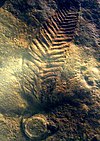| Petalonamae Temporal range: 635.0–508.0 Ma PreꞒ Ꞓ O S D C P T J K Pg N Ediacaran-Cambrian | |
|---|---|

| |
| Charniodiscus arboreus (=Arborea arborea) | |
| Scientific classification | |
| Domain: | Eukaryota |
| Kingdom: | Animalia |
| Superphylum: | †Vendobionta |
| Phylum: | †Petalonamae Phlug, 1972 |
| Subtaxa | |
| Synonyms | |
| |
The petalonamids (Petalonamae) are an extinct group of archaic animals typical of the Ediacaran biota, also called frondomorphs, dating from approximately 635 million years ago to 516 million years ago. They are benthic and motionless animals, that have the shape of leaves, fronds (frondomorphic), feathers or spindles and were initially considered algae, octocorals or sea pens. It is now believed that there are no living descendants of the group, which shares a probable relation to the Ediacaran animals known as Vendozoans.
It is commonly conjectured that the organisms were fluffy at least in appearance, as if "inflatable." They are particularly difficult to classify phylogenetically. Lacking mouths, intestines, reproductive organs, and with no preserved evidence of internal structures, these organisms' existence is very strange by current standards. The most widely accepted hypothesis is that they could suck nutrients from the water around them by osmosis. The fronds were composed of branched, tubular structures, and the organism was anchored to the ground by a bulbous structure.
The symmetry is generally bilateral, like a feather with one axis and two sides. It can also be trilateral, with one axis and three sides, as seen in the most basal ones, the erniettomorphs.
Distribution
Ediacaran of Canada, Namibia and Russia.
Phylogeny
| Animalia |
| |||||||||||||||||||||||||||||||||||||||||||||||||||||||||
See also
- †Vendobionta
- †Trilobozoa, another group of Edicaran animals who have trilateral symmetry, similar to basal petalonams.
- †Proarticulata, another group of enigmatic Ediacaran animals
- Eumetazoa
References
-
Pflug, Hans D. (1 Jan 1970). "Zur Fauna der Nama-Schichten in Südwest-Afrika (Teil II)" [On the fauna of the Nama Beds in Southwest-Africa (Part II)]. Palaeontographica Abteilung A (in German). A135 (3–6): 198–231. Part II. Rangeidae, Bau und systematische Zugehörigkeit .
- see also
- ^ "†phylum Petalonamae (Pflug, 1972)". Paleobiology database (paleobiodb.org) (basic taxon info). 121415.
- Seilacher, A. (2007). Trace Fossil Analysis. Springer.
- Ivantsov, A.Y.; Grazhdankin, D.V. (1997). "A new representative of Petalonamae from [the] upper Vendian of Arkhangelsk region". Paleontological Journal. 31 (1).
- Laflamme, Marc; Xiao, Shuhai; Kowalewski, Michał (2009). "Osmotrophy in modular Ediacara organisms". Proceedings of the National Academy of Sciences of the USA. 106 (34): 14438–14443. doi:10.1073/pnas.0904836106. PMC 2732876. PMID 19706530.
- Hoyal Cuthill, Jennifer F.; Han, Jian (7 August 2018). "Cambrian petalonamid Stromatoveris phylogenetically links Ediacaran biota to later animals" (PDF). Palaeontology. 61 (6): 813–823. doi:10.1111/pala.12393. ISSN 0031-0239 – via U. Essex.
- Buss, Leo W.; Seilacher, Adolf (1994). "The phylum Vendobionta: A sister group of the Eumetazoa?". Paleobiology. 20 (1): 1–4. doi:10.1017/S0094837300011088. ISSN 0094-8373. S2CID 89131248.
Further reading
- Hoyal Cuthill, Jennifer F.; Han, Jian; Álvaro, Javier (2018) . "Cambrian petalonamid Stromatoveris phylogenetically links Ediacaran biota to later animals". Palaeontology. 61 (6) (published November 2018): 813–823. doi:10.1111/pala.12393.
- Martinsson, Anders (October 1978). "Keys to German palaeontological and stratigraphical terminology". Lethaia. 11 (4): 292. doi:10.1111/j.1502-3931.1978.tb01883.x.
- "The Rise of Animals: Evolution and diversification of kingdom Animalia. Fedonkin M.A., Gehling J.G., Grey C., Narbonne G.M., Vickers-Rich P. (2007)". Integrative Zoology (book review). 3 (4): 333. 14 December 2008. doi:10.1111/j.1749-4877.2008.00114.x.
- Glaessner, M.F.; Walter, M.R. (1975). "New Precambrian fossils from the Arumbera Sandstone, Northern Territory, Australia". Alcheringa: An Australasian Journal of Palaeontology. 1 (1): 59–69. doi:10.1080/03115517508619480.
- Grazhdankin, Dmitriy (2014). "Patterns of evolution of the Ediacaran soft-bodied biota". Journal of Paleontology. 88 (3): 269–283. doi:10.1666/13-072. S2CID 129317326.
| Petalonamae | |||||||
|---|---|---|---|---|---|---|---|
| |||||||
| Arboreomorpha |  | ||||||
| Erniettomorpha | |||||||
| Rangeomorpha |
| ||||||
| Unclassified | |||||||
| Part of the Ediacaran biota | |||||||
| Taxon identifiers | |
|---|---|
| Petalonamae | |
This prehistoric animal article is a stub. You can help Misplaced Pages by expanding it. |
This Ediacaran biota-related article is a stub. You can help Misplaced Pages by expanding it. |